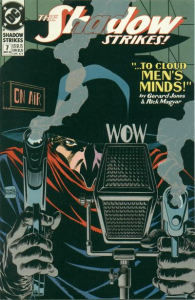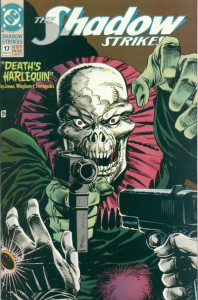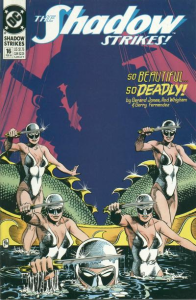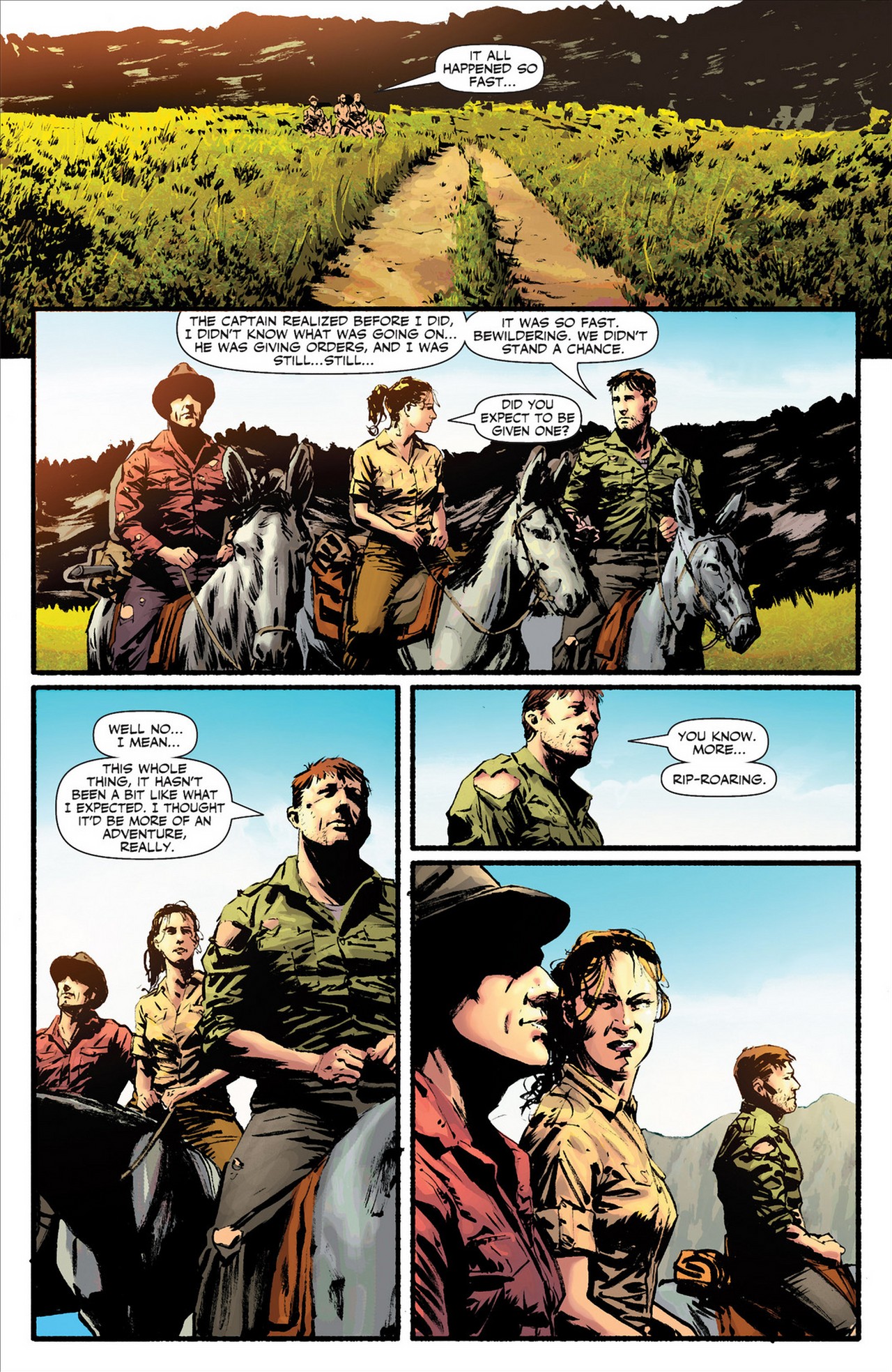The mid-to-late ‘80s were the true golden age of comic books. For a few years, the industry was set on trying out all kinds of ideas and outright bombarding readers with one memorable comic after another, featuring both new and classic characters… For instance, take the Shadow, the big-nosed vigilante with a hypnotic girasol ring and a network of underground operatives at his command. After a having a go at an iconoclastic, cartoony present-day version of this crimefighter, DC shifted gears in 1989 and put out a series that was, essentially, the polar opposite of that.
And yet, in its own way, The Shadow Strikes! can be just as satisfying as its predecessor.
The first obvious difference between the two takes is that the earlier one, launched in 1986 and written by Howard Chaykin and Andrew Helfer, was mostly set in the eighties, whereas The Shadow Strikes! went back to the Shadow’s roots in the Great Depression, rebooting the old property as a straightforward period piece.
The 1930s weren’t just a decor, but the very soul of the comic. It looks as if, before he sat down to work on TSS!, writer Gerard Jones came up with an extensive list of all the tropes and recognizable references related to this decade (later, he appears to have done the same regarding the 1950s for the mind-bending mini-series Martian Manhunter: American Secrets). Jones really mined the social turbulence of the Depression era for all its worth… Besides the usual stories about gang wars and racial intolerance, there was the whodunit ‘Crimson Dreams,’ which zoomed in on the politics of Hollywood’s old studio system, and the riveting ‘The Strike,’ which addressed the labor struggles of construction workers with the verve of a rocking unionist anthem.
(Not that it’s possible to completely escape your own time – after all, for all of The Shadow Strikes!’s commitment to immersing readers in a pre-Cold War past, I can’t help but detect in the thirties’ debates about military readiness and US-USSR rapprochement a distorted reflection of the concerns of the late eighties… And later on, a grand-scale storyline about oil business was clearly a nasty jab at the Gulf War!)
The list of cameos included Amelia Earhart, Mao Tse-tung, and even Gerard Jones’ own father. Moreover, Jones reverse-engineered nods to various works of fiction, from Chinatown (Jake, the cop in ‘Fireworks’) to Sullivan’s Travels (Sinclair Beckstein, the author of the play Oh Brother, Where Art Though?, in ‘To Cloud Men’s Minds’). In issue #29, guest writer Don Kraar and guest artist Dan Spiegle got in on the action as well, with a visual homage to the climax of Raiders of the Lost Ark.
Above all, Jones paid tribute to The Shadow’s pulps and to the radio drama voiced by Orson Welles, including a team-up between the violent, no-nonsense vigilante and a lively version of the future director of Citizen Kane… The joke was that the ersatz-Welles openly identified himself with the Shadow, given that they were both masters of disguise, surprise, and choreographed misdirection. The issue (#7) even culminated in a transparent riff on the hall of mirrors’ scene from Welles’ The Lady from Shanghai (a film that looks gorgeous but whose plot doesn’t make a lick of sense).
In fact, just like the recent Fargo TV show has expanded beyond its initial influence and become a love letter to the Coen brothers’ entire oeuvre, The Shadow Strikes! also feels like it went way beyond Orson Welles’ radio show, bringing to mind many of his greatest works from later decades. There’s Mr. Arkadin’s frenetic, globetrotting intrigue, The Immortal Story’s orientalist tinge, F for Fake’s metafictional games, The Trial’s breathtaking visuals, Touch of Evil’s hypnotic trifecta of film noir, gothic motifs, and psychological horror…
Touch of Evil seems particularly suited for comparison. After all, on paper, that project probably sounded like just another hardboiled 1950s’ crime flick, with subplots about dirty cops (Where the Sidewalk Ends, Shield for Murder, Rogue Cop), racism (Odds Against Tomorrow, Bad Day at Black Rock, The Killing), and threats to the hero’s family (The Big Heat, The Desperate Hours, Crime Wave), but Welles’ baroque direction created an unique masterpiece. Likewise, while The Shadow Strikes! might sound like just another potboiler, the series was significantly lifted by its ‘director’ – artist Eduardo Barreto, who drew most of the early issues.
Ed Barreto drew inspiration from 1930s’ adventure comics by the likes of Milton Caniff and Noel Sickle, adopting a luscious style that couldn’t be farther from the exaggerated, whimsical art of Bill Sienkiewicz and Kyle Baker in the previous Shadow series. Credit for TSS!’s panache should also go to the palette of colorist Anthony Tollin (an unabashed fan of the Shadow who provided text pieces about the character’s various media adaptations in the back matter).
For a sense of the vicious gravitas of Barreto’s art, check out this sequence where the Shadow beheads Rasputin (with chilling sound effects courtesy of letterer David Cody Weiss):
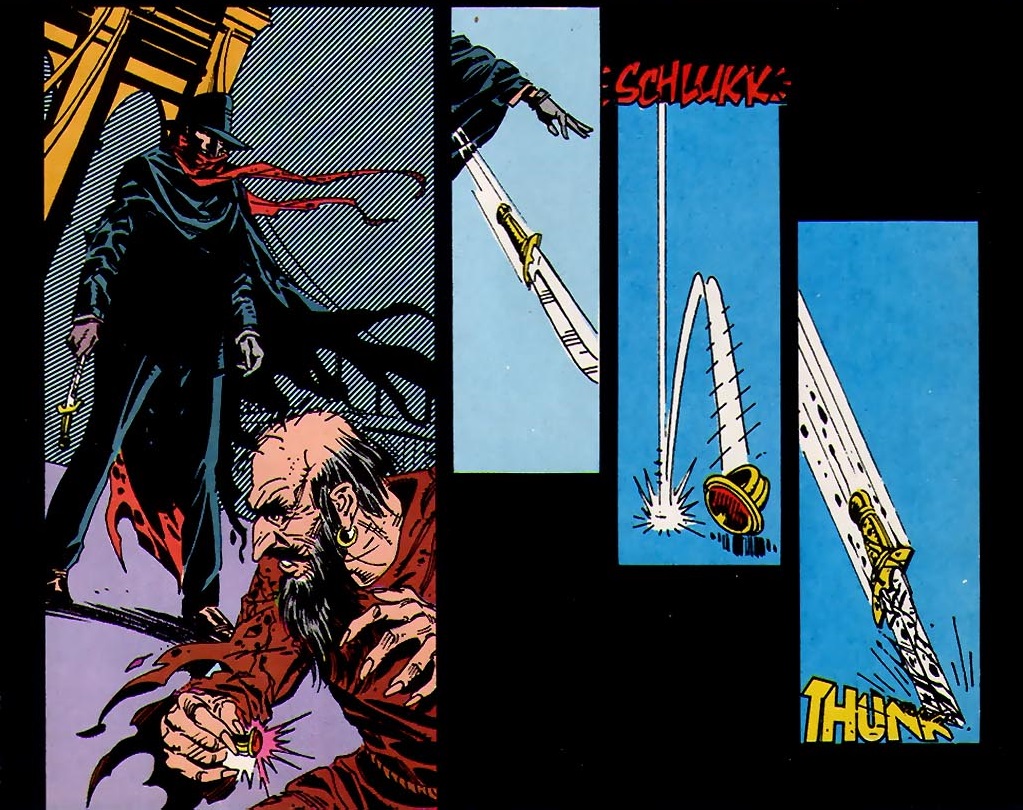
 The Shadow Strikes! #4
The Shadow Strikes! #4
(Halfway through the series, Rod Whigham took over the pencils, mostly inked by Gerry Fernandez. Their storytelling wasn’t quite as strong as Barreto’s, but they nailed the moody feel of the comic.)
The gritty visual style speaks to another, more general contrast between The Shadow Strikes! and its immediate predecessor. While Howard Chaykin and Andy Helfer had approached the material as a wacko comedy (Chaykin was just off the satirical American Flagg! and Helfer was the editor of the bwahaha era of Justice League International), Gerard Jones seemed to be consciously avoiding any sense of irony. His take on the Shadow was as earnest as it gets – a two-fisted yarn packed with desperate people scheming and stalking and double-crossing each other at every turn. Notably, not only did Jones treat the protagonist’s different alter egos (high society snob Lamont Cranston, WWI pilot Kent Allard) with respect, he also did a fine job of humanizing the Shadow’s agents, especially the plucky socialite Margo Lane, whose mysterious past kept providing interesting twists almost until the end.
All in all, TSS! was one mean, unashamedly dark series, featuring brutal thrills, cynical political intrigue, and more than a couple of instances of implied sexual abuse. Unlike other revamps from this era (like Green Arrow), however, this was less a mature reimagining of a juvenile franchise than a return to its grim origins, sharing much of the spirit of Walter B. Gibson’s vintage stories.
That said, The Shadow Strikes! was not entirely devoid of humorous touches:

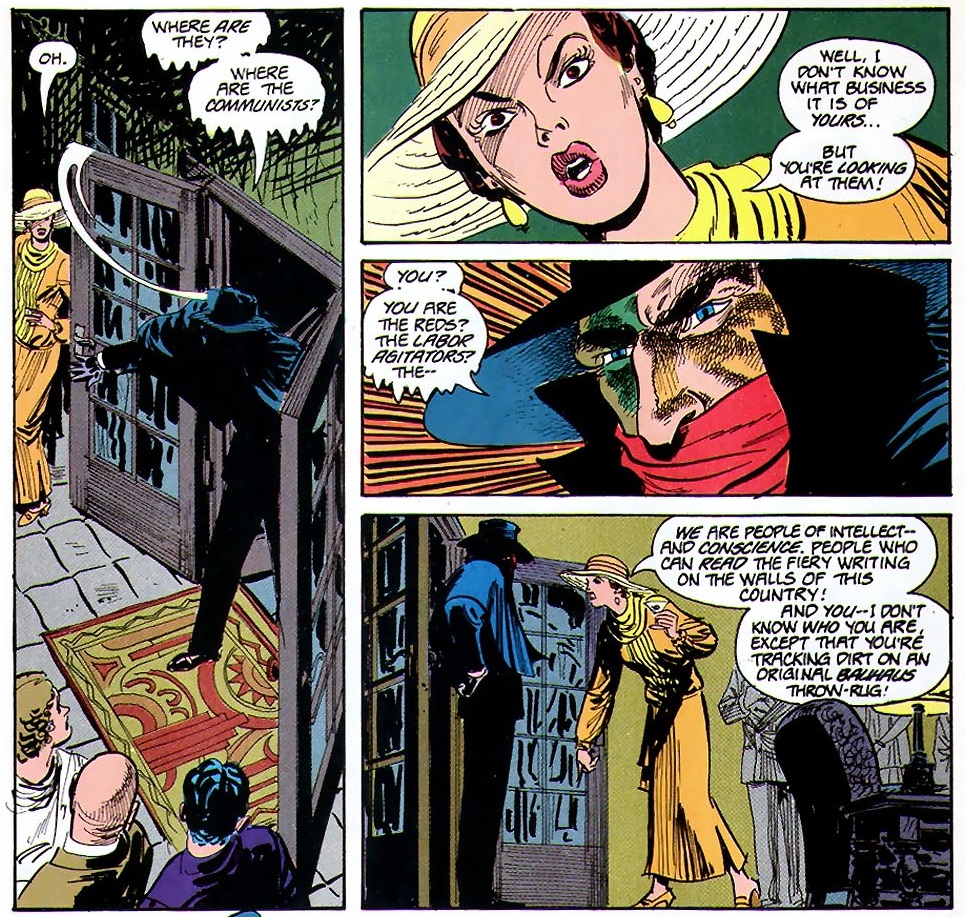 The Shadow Strikes! Annual #1
The Shadow Strikes! Annual #1
In terms of pure fun, one of the coolest tales – and a fairly obvious editorial move – involved The Shadow Strikes! crossing over with DC’s reboot of another pulp hero from the ‘30s. Denny O’Neil had revamped the muscular scientist Doc Savage, first in a neat 1987 mini-series and then in an ongoing that opened with a no-holds-barred saga about moon aliens manipulating the Cold War. By the time TSS! debuted, Mike W. Barr had taken over the writing chores from O’Neil. Barr’s run wasn’t as remarkable – much of it just focused on bringing back old characters – but there were a few inspired moments (I quite enjoyed the annual about the 1936 Olympics).
Co-written by Gerard Jones and Mike Barr, the four-part ‘The Conflagration Man’ brought together the two adventurers and their respective teams in a quest to prevent a powerful ray-gun from falling into the hands of a megalomaniac arms manufacturer. Jones and Barr crafted an elaborate chess game of a story, with the plot twisting and turning as the large cast moved on multiple fronts. And, naturally, much was made of the contrast between the leading heroes – indeed, shortly after crossing paths, Doc Savage tried to lobotomize the Shadow!
After the obligatory initial clash, the two characters began to bond, although not without a degree of one-upmanship:
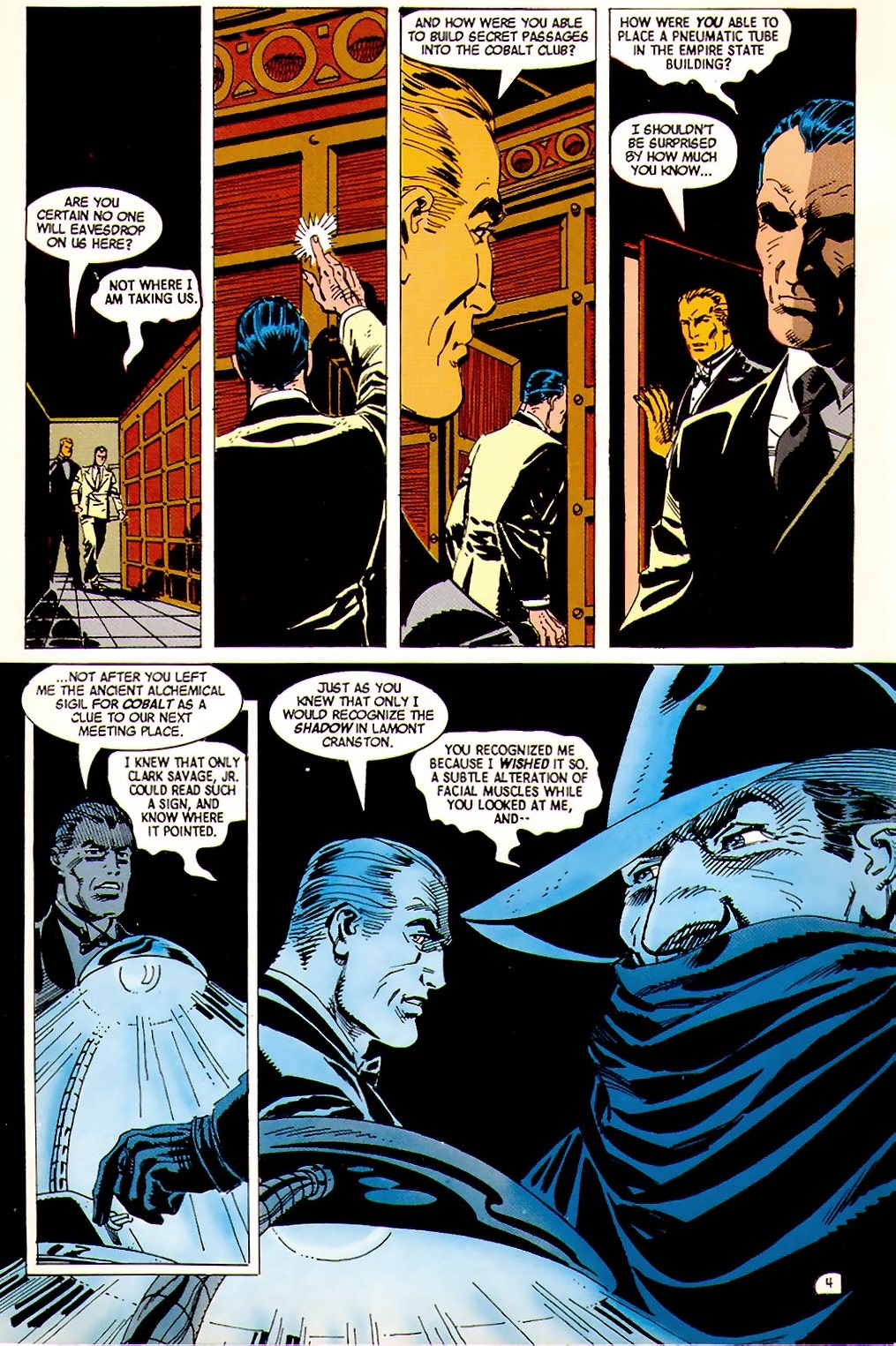
 The Shadow Strikes! #6
The Shadow Strikes! #6
To be sure, not all stories were equally engaging, but even when the plotting grew more uneven the pulpy ‘30s atmosphere was still enough to carry the comic (the same thing applies to Dave Stevens’ The Rocketeer – which includes a Shadow guest-appearance – and to Matt Wagner’s Sandman Mystery Theatre).
There have been other Shadow comics since then (the best-looking being ‘Hell’s Heat Wave,’ illustrated by Gary Gianni), but my curiosity was particularly prickled four years ago, when I heard that Garth Ennis was going to write the latest relaunch of the character, for Dynamite. Given that Ennis is just as comfortable doing racy slapstick as doing straight-faced grit, I wondered which version we were going to get, the ’86 one or the ’89 one… Well, his version (collected as ‘The Fire of Creation’) sure felt like a worthy heir of The Shadow Strikes!, albeit way more hardcore. Set in occupied China in the late 1930s, the comic benefited from Ennis’ flair for historical insight. It also indulged in many of his favorite tropes, like the long stretches of witty repartee or the inclusion of unredeemably despicable villains that just make you root for their bloody comeuppance after every page. And just in case you have any doubts about the comic’s ruthlessness, you get one of those typical Ennis moments when a supporting character realizes that he’s not in your run-of-the-mill escapist fiction:


